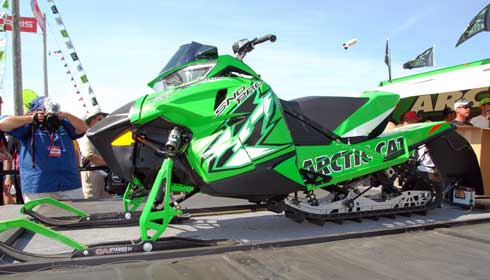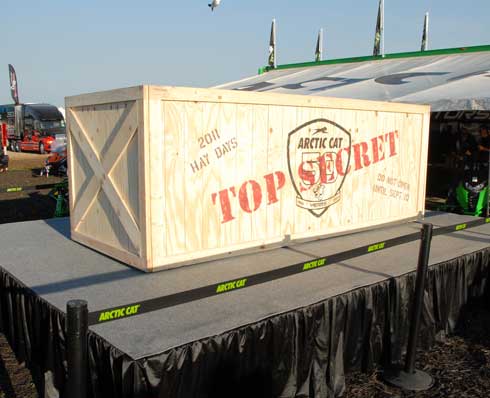
As many here guessed, the announced Arctic Cat unveiling at Hay Days was the new-for-2012 Arctic Cat Sno Pro 600 ProCross race sled. For the first time since 2004, the Arctic Cat race sled is largely identical to the Arctic Cat sleds the rest of us ride.
As has been the case in recent season, both a cross-country and snocross version will be available.
Judging by the spec’s of the new racer, there will be a few trick items available for ProCross and ProClimb chassis machines in the near future.
The 2012 Sno Pro racer features the same new engineering that defines the ProCross and ProClimb chassis: Tapered tunnel; Arctic Race Suspension with 30-degree A-arm mounting; tall one-piece, forged spindles with ball joints; Arctic Drive System; Torque Control Link and more.
But it’s also a defined race sled, thus receives some competition-focused engineering dedicated to added performance, reduced weight, increased strength and optimized ergonomics.
The Radial Master Cylinder brake system is retained, with the caliper and disc on the driveshaft, but a larger 9/16-in. bore on the master-cylinder and race-spec pads increase braking power, while a machined disc shaves weight.
Likewise, the single bell-crank steering system is retained, but reworked to incorporate the variable steering ratio used on Sno Pro race sleds since 2005.
To reduce weight, twin-sheet plastic construction of items like the fuel tank and air box shaves a few pounds. The XC racer will get a 12-gallon tank while the snocrosser sports a 5-gallon unit, and each is clear for simplified fuel level sighting.
Unlike the standard ProCross/ProClimb models, the racer’s airbox is now the nose cone (with additional area inside the hood) – rather than pulling air from behind the windshield – for a more direct path to the carburetors with cooler air.
The Peak Torque Load (PTL) drive shaft of previous seasons has been replaced with a new Arctic Cat-engineered Torque Overload Sensing bottom “slipper” gear. Both the drive and driven shafts are hollow/tubular (with welded ends) to reduce weight.
The hood shape is identical to standard ProCross/ProClimb models, however, the removable body panels have “grown” to incorporate more the hood, increasing access to the engine bay when removed.
A roughly 2-in. increase in seat height eases the transition from sitting to standing on the Sno Pro, while new “gripper” material improves rider control.
In a strong departure from the previous Sno Pro (intent to eliminate the tendency to swap in fast-chop) the rear suspension on the ’12 model is a race version of the Slide-Action design, complete with Torque Sensing Links, longer front arm, revised geometry and a newly-designed, high-flow Fox remote reservoir rear shock.
In a nod to what most racers spec their sleds with, Arctic Cat added Fox FLOAT X EVOL shocks (with comp/rebound adjustability) to the front suspension.
The same 600R race engine graces the new Sno Pro, including its 40mm Mikuni TM carbs, adjustable timing, V-Force reeds, Exhaust Pipe sensor and Hot Start button, but with a reworked pipe and silencer for the new chassis.
The snocross Sno Pro comes with 15 x 128 x 1.7-in. lug track and C&A skis, while the cross-country version gets the 1.25-in. lug Cobra 2-ply and Arctic Cat skis.
And yes, the Sno Pro is white on the right side, green on the left.
The sled that was unveiled by CatGirl-for-the-day Meisha Johnson had a few prototype parts (like the fuel tank) and was assembled just in time for the event, thus it hasn’t yet hit the scales. Based on my conversation with engineers, the expected weight for the new sled will be a few pounds lighter than last year’s machine.
While there might have been a few disappointed Cat fans at Hay Days who were hoping/expecting a 600 consumer sled, there are a few goodies on the Sno Pro racer that will undoubtedly be available as accessory items in the future, such as the lightweight brake disc; powered-up 9/16-in. master cylinder and race spec pads and Torque Overload Sensing bottom gear.
Better still, with Cat racing the ProCross chassis, there will undoubtedly be more improvements/engineering that will unfold in the coming seasons which, like the days of the ZR, can trickle down to the consumer sleds.
Racing fulfils its maximum potential when it directly influences consumer machines. Judging from what I see with the new Sno Pro 600, success looks inevitable both on and off the track.
